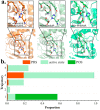Insight into Structural Characteristics of Protein-Substrate Interaction in Pimaricin Thioesterase
- PMID: 30781619
- PMCID: PMC6412417
- DOI: 10.3390/ijms20040877
Insight into Structural Characteristics of Protein-Substrate Interaction in Pimaricin Thioesterase
Abstract
As a polyene antibiotic of great pharmaceutical significance, pimaricin has been extensively studied to enhance its productivity and effectiveness. In our previous studies, pre-reaction state (PRS) has been validated as one of the significant conformational categories before macrocyclization, and is critical to mutual recognition and catalytic preparation in thioesterase (TE)-catalyzed systems. In our study, molecular dynamics (MD) simulations were conducted on pimaricin TE-polyketide complex and PRS, as well as pre-organization state (POS), a molecular conformation possessing a pivotal intra-molecular hydrogen bond, were detected. Conformational transition between POS and PRS was observed in one of the simulations, and POS was calculated to be energetically more stable than PRS by 4.58 kcal/mol. The structural characteristics of PRS and POS-based hydrogen-bonding, and hydrophobic interactions were uncovered, and additional simulations were carried out to rationalize the functions of several key residues (Q29, M210, and R186). Binding energies, obtained from MM/PBSA calculations, were further decomposed to residues, in order to reveal their roles in product release. Our study advanced a comprehensive understanding of pimaricin TE-catalyzed macrocyclization from the perspectives of conformational change, protein-polyketide recognition, and product release, and provided potential residues for rational modification of pimaricin TE.
Keywords: macrocyclization; molecular dynamics (MD) simulation; pimaricin thioesterase; pre-reaction state; protein-substrate interaction.
Conflict of interest statement
The authors declare no conflict of interest.
Figures











Similar articles
-
Insights into specificity and catalytic mechanism of amphotericin B/nystatin thioesterase.Proteins. 2021 May;89(5):558-568. doi: 10.1002/prot.26041. Epub 2021 Jan 15. Proteins. 2021. PMID: 33389775
-
The thioesterase domain from the pimaricin and erythromycin biosynthetic pathways can catalyze hydrolysis of simple thioester substrates.Bioorg Med Chem Lett. 2007 Jun 1;17(11):3034-7. doi: 10.1016/j.bmcl.2007.03.060. Epub 2007 Mar 23. Bioorg Med Chem Lett. 2007. PMID: 17428661
-
Theoretical Studies of Mutual Effects between 6-m-r Hemiketalization and 26-m-r Lactonization in Pimaricin Thioesterase.Chem Asian J. 2023 Apr 3;18(7):e202201229. doi: 10.1002/asia.202201229. Epub 2023 Feb 13. Chem Asian J. 2023. PMID: 36755200
-
A Single Active Site Mutation in the Pikromycin Thioesterase Generates a More Effective Macrocyclization Catalyst.J Am Chem Soc. 2017 Sep 27;139(38):13456-13465. doi: 10.1021/jacs.7b06436. Epub 2017 Sep 19. J Am Chem Soc. 2017. PMID: 28836768 Free PMC article.
-
Towards a characterization of the structural determinants of specificity in the macrocyclizing thioesterase for deoxyerythronolide B biosynthesis.Biochim Biophys Acta. 2016 Mar;1860(3):486-97. doi: 10.1016/j.bbagen.2015.11.007. Epub 2015 Nov 22. Biochim Biophys Acta. 2016. PMID: 26592346
References
-
- Gil J.A., Martin J.F. In: Biotechnology of Antibiotics. 2nd ed. W. Strohl M., editor. Dekker; New York, NY, USA: 1997.
-
- Szlinder-Richert J., Mazerski J., Cybulska B., Grzybowska J., Borowski E. MFAME, N-methyl-N-d-fructosyl amphotericin B methyl ester, a new amphotericin B derivative of low toxicity: Relationship between self-association and effects on red blood cells. Biochim. Biophys. Acta Gen. Sub. 2001;1528:15–24. doi: 10.1016/S0304-4165(01)00166-0. - DOI - PubMed
-
- Cereghetti D.M., Carreira E.M. Amphotericin B: 50 Years of Chemistry and Biochemistry. Synthesis. 2006;37:914–942. doi: 10.1002/chin.200626224. - DOI
MeSH terms
Substances
Grants and funding
LinkOut - more resources
Full Text Sources
Research Materials

